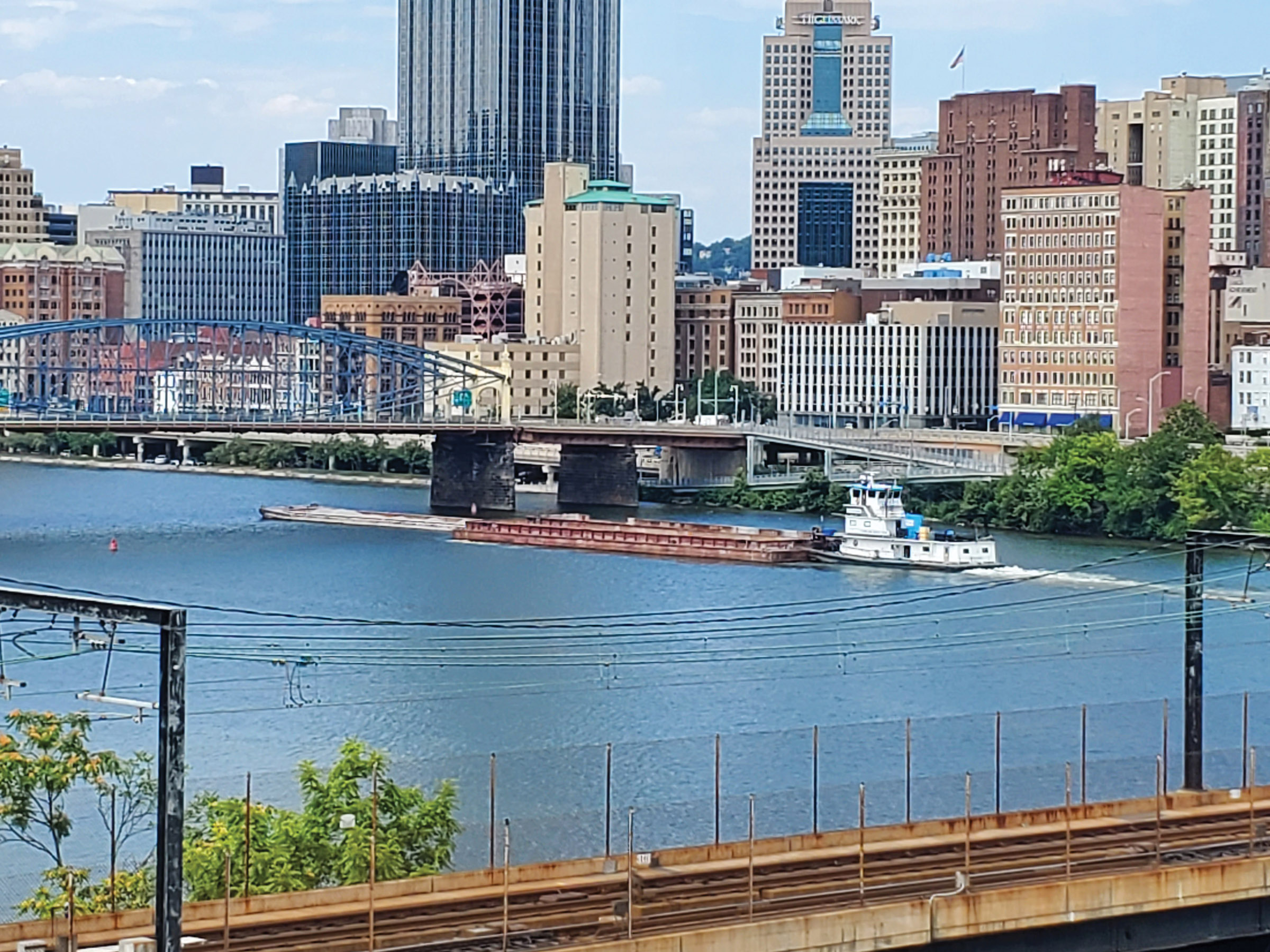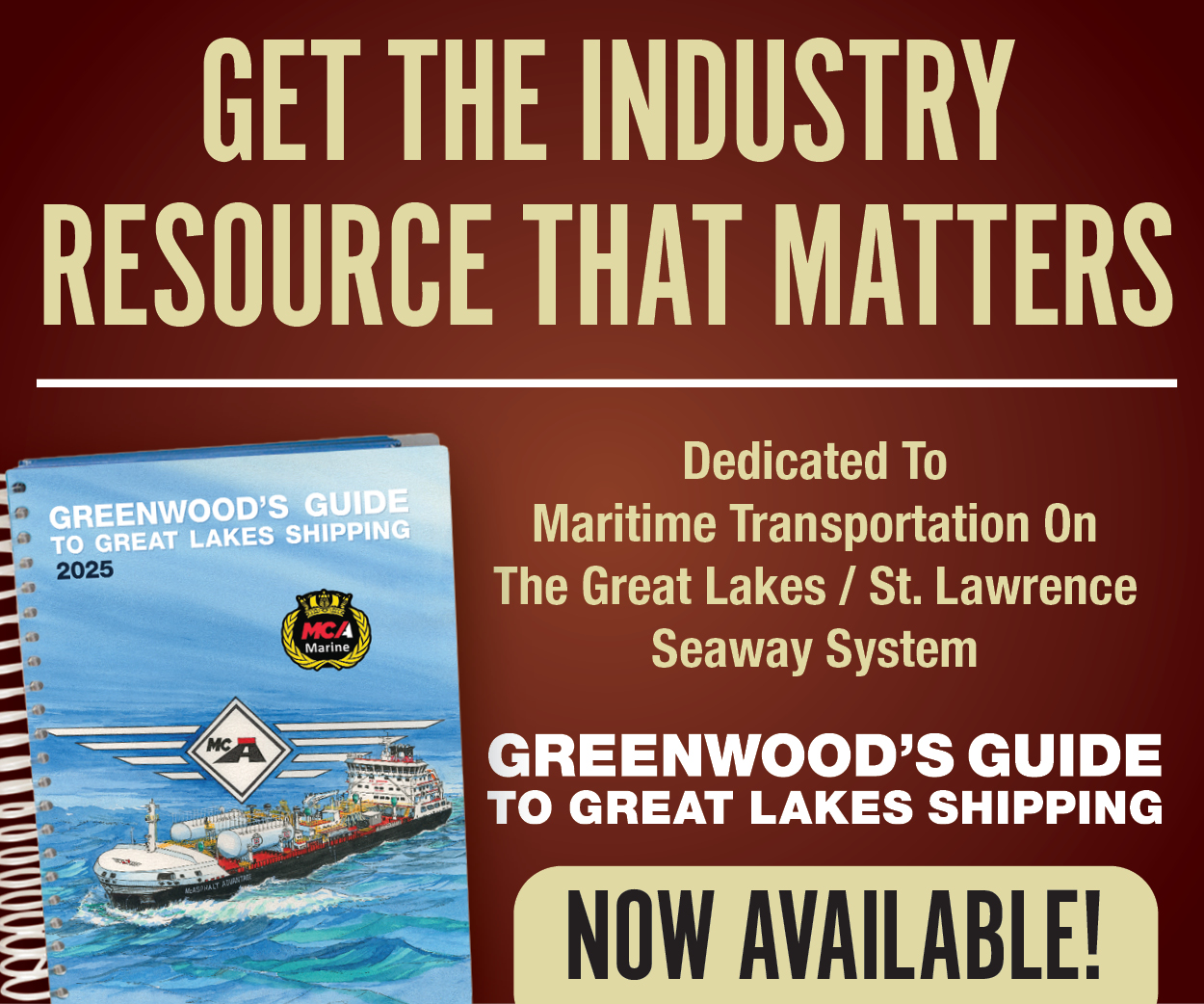Executive director Mary Ann Bucci describes the Port of Pittsburgh Commission (PortPitt) as a chamber of commerce for the river system in western Pennsylvania.
The four-person office works to promote the commercial and recreational use of the rivers along 200 navigable river miles, a reach that includes 200 private terminals and other river-related businesses. The port district covers 13 counties in Pennsylvania and all three of the region’s navigable rivers: the Ohio, Monongahela and Allegheny. PortPitt is the fourth largest inland port in the nation.
A system of 16 locks and dams keeps the rivers navigable for the people and businesses along them. In 2021, the National Waterways Foundation determined that the Pittsburgh Port District’s river terminals, inland waterways and inland waterways-dependent industries supported nearly 92,000 jobs with $7.2 billion in personal income, giving rise to $1.5 billion in state and local tax revenue. The same year, 16.4 million tons of freight valued at $1.1 billion moved on the district’s waterways. That movement is equivalent to more than 411,000 trucks.
Major industries supported by the port district’s waterways include mining, utilities, petroleum and coal product manufacturing and construction. Top products, comprising 84 percent of the total value of freight moved on the system, are coal, $573 million annually; waste/scrap, $308 million; and natural gas and other hydrocarbons, $55 million.
Often, the port commission serves as a liaison between businesses and government agencies, helping to secure economic development opportunities and safeguarding the river’s navigational, recreational and environmental benefits.
One major role is helping businesses to secure access to grant opportunities. PortPitt successfully garnered and administers a Congestion Mitigation and Air Quality Program grant from the Federal Highway Administration, helping to facilitate the upgrading of towboats operating within the district with cleaner burning diesel engines. Recent research and studies have also been undertaken to explore the viability of using liquid natural gas fuel for towboats.
The first round of grant funding resulted in $22 million in projects in a 50/50 cost-share program in which towboat engines were upgraded to meet Tier 3 emissions requirements, helping to ease highway congestion and ship more products on rivers. A second round of ongoing funding, which also expands the program to shoreside cranes and conveyors, means that $34 million has been or will be distributed to upgrade more than three dozen vessels and improve river terminal emissions.
“It’s a real job creator, too, because, a lot of times, when these vessels are in dry dock, they’ll redo the whole vessel, not just the engine,” Bucci said.
The port also helped the region to receive a federal Marine Highway designation for the Allegheny and Mon rivers as the M-79 in 2023, and serves as the route co-sponsor in Pennsylvania for both the M-79 and the M-70, which covers the Ohio River, marketing and program manager Scott Harshman said. It has also assisted terminals in applying for both the U.S. Department of Transportation’s Port Infrastructure Development Program (PIDP) and Small Shipyard Grant Program, in addition to other federal and state funding opportunities.
Lower Mon Issues
Prior to the planned breach of Monongahela River Lock and Dam 3 at Elizabeth, Pa., in July 2024, the port was involved in helping communicate the expected effects on water levels to area businesses and in helping them to apply for available funding to upgrade docks and other infrastructure, assistant director Matthew Pavlosky said.
After the Corps breached the dam, the port commission has helped businesses in voicing concerns with some unexpected issues with water levels that settled out higher or lower than originally anticipated by the Corps of Engineers or issues with new patterns in water flows. Most recently, the commission gathered information from these businesses and applied earlier this month for a PIDP grant to help remediate these issues, Pavlosky said.
In some areas, he noted, businesses along the river that had operated at the authorized navigable depth of at least 9 feet reported as little as 4 feet of water, especially during the summer 2024 drought. As a result, some vessels grounded, and shippers have had to light load barges, meaning it now takes more barges, time and money to ship the same amount of cargoes.
“With siltation and changes in the river pattern, we’re stepping up to help assist, such as with widening that area,” Pavlosky said of businesses’ access channels. “We’re trying to get it so they can resume normal business.”
One way the port has helped is by connecting businesses with the Corps of Engineers to expedite permitting for dredging between businesses’ terminals and out to the main channel of the Mon, Bucci said. While previous permits generally limited dredging to 50 feet, areas that now have lower water levels might now need a 250-foot “driveway” to their facilities, she said.
The port commission was also instrumental in helping to obtain $4.2 million in emergency funding from the state of Pennsylvania for dredging to maintain the Lower Mon’s navigability and the terminals’ connectivity.
John Ross, senior operations manager at Donora River Terminal in Donora, Pa., said he appreciates the port commission’s work in applying for the PIDP grant to try to help affected businesses.
So far, he said, the terminal has spent more than $793,000 in dredging, including $67,000 in August alone. Despite that, he said, the company has been able to use only 60 percent of its fleeting area since Dam 3’s removal.
“With any high water at all, it’s just sanding us right back in, and we’re right back to where we started,” he said.
While Donora anticipated and prepared for a drop of 3 feet at its dock, it was 6 to 7 feet instead, he said. That has added $25,000 to $35,000 a month in additional operating costs, he said.
Raymond Somich is the global director of government and external affairs for Synthomer, a supplier of polymers, including adhesives, coatings and other materials used in construction, manufacturing, healthcare and consumer products settings, that has operated from its facility in Jefferson Hills, Pa., for about 75 years. He said his company needed to build a new dock with a higher elevation because the dam’s breaching caused higher water levels at its terminal.
“We now see a change in the river flow pattern,” he said. “As a result of the removal of the lock and dam system, we see heavy silt depositing occurring. We have water swirl in some of the cove or tuck areas up and down the river.”
He added, “We can see the silt coming down the river, especially after weather events, so we know that depositing is happening. We do see an active swirl pattern of deposits happening in neighboring areas to our operation.”
Somich anticipates that, as a result, the business may need to conduct dredging to ensure it can maintain its supply chain, which involves receiving polymer feedstocks that must arrive by barge, traveling upriver from the Gulf.
“We are proactively working with the Port of Pittsburgh, and we’re in communication with businesses up and down the Lower Mon,” Somich said.
Continued Advocacy
The port commission is also focused on raising awareness of the importance of receiving efficient funding for the Corps of Engineers’ ongoing construction of a new, larger lock at Montgomery Lock and Dam. Montgomery is the first of three locks to be modernized and enlarged as part of the Upper Ohio Navigation Project, which also involves Dashields and Emsworth locks and dams, the three oldest and smallest locks on the Ohio River.
It is also critically important for the Corps to receive operations and maintenance funds in an amount that ensures continued operability of existing locks, many of which are well past their 50-year design lifespan, Bucci said.
“We’re excited about the opportunities ahead of us,” Harshman said, noting that when these projects are completed, the Pittsburgh region will have the most modern lock and dam infrastructure on the nation’s river system.
Another advocacy effort is the Save The Allegheny River (STAR) regional coalition, for which Bucci is a co-chair. The group plans to conduct an economic study to determine the value of recreational, hydropower and municipal and industrial water intake uses of the Allegheny, in addition to commercial usage, which is already considered in determining a river’s level of service for lock operations. Such a study could potentially be used to press the case for increased operation of locks on the Upper Allegheny. None of the locks is currently operative around the clock, and some are only active on weekends and holidays during much of the year. Increased lock operation could help to reinvigorate business along the river, Bucci said.
Maintaining the rivers is important for all users, whether for commercial or recreational purposes, Harshman said. The port also works to promote safety along them as that benefits everyone, he said. One of the port’s efforts to increase awareness of safety is through the Safe Boating Council, for which Harshman serves as secretary.
The port also helps to educate area residents about the rivers and their importance to the region each spring through the Our Three Rivers, Up Close and Personal course for adult students through the Osher Lifelong Learning Institute at Carnegie Mellon University. The six-week class for lifelong learners involves hands-on opportunities for students to learn about the rivers and the businesses up and down them. Highlights of the class this year included a tour of the John P. Murtha Locks and Dam on the Mon River, a tour of Industry Terminal & Salvage Company on the Ohio River, attending a Waterways Association of Pittsburgh luncheon and visiting Three Rivers Rowing Association and its boat house along the Allegheny River.
“Some folks have never been on the river, and they’ve been in Pittsburgh for decades,” Harshman said, adding, “We’ve had a number of students over the years say that it was their favorite Osher class.”
Through all its efforts, the Port of Pittsburgh Commission is increasing awareness of how the rivers are the most economical, efficient, safest and most environmentally friendly mode of transportation for shipping bulk cargoes, Bucci said. By taking on administrative and advocacy roles, Pavlosky added, it helps the surrounding businesses maintain their focus on what they do best, producing energy and products critical to the nation’s economy.
————
Featured photo caption: A tow passes beneath one of Pittsburgh’s many bridges over the Monongahela River. The Pittsburgh Port District comprises 200 river miles on the Ohio, Monongahela and Allegheny rivers. It is the fourth largest inland port district in the country. (Photo by Mike Brinza/Port of Pittsburgh Commission)




